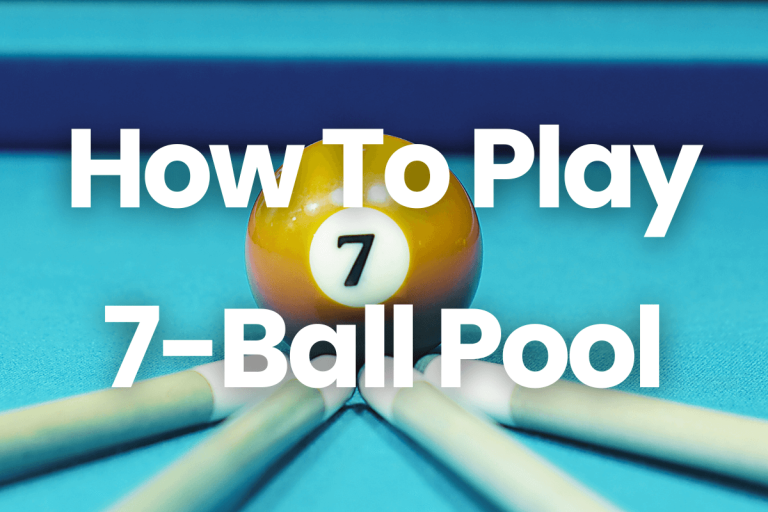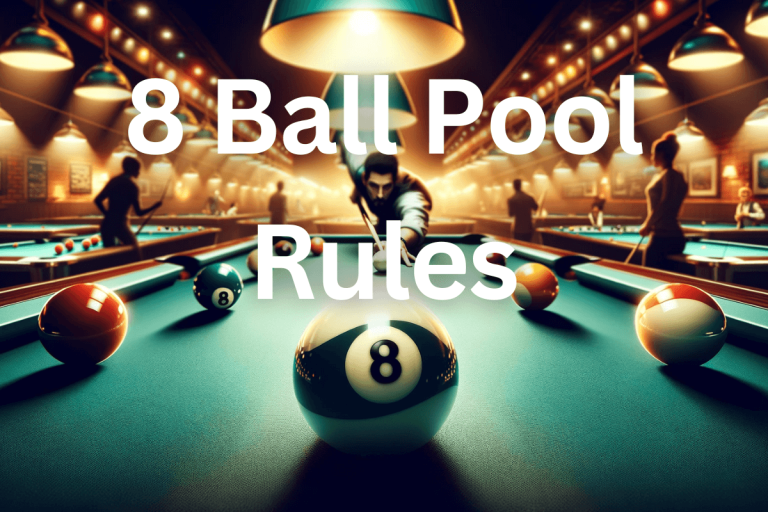How to Play Bank Pool | Mastering the Game with Easy, Expert Tips! (2024)
Bank Pool, a captivating variation of cue sports, stands out for its unique challenge and strategic depth. This guide delves into how to play Bank Pool, highlighting its growing popularity among pool enthusiasts. Distinguished by its focus on bank shots, where balls must rebound off the table’s cushions before pocketing, Bank Pool demands precision and tactical prowess. This distinct feature sets it apart from other pool games, offering a thrilling experience for players seeking a blend of skill and strategy in their gameplay.
History of Bank Pool
Bank Pool, with its intriguing blend of skill and strategy, traces its origins back to the early days of billiards. It evolved from the classic game of “straight pool,” but with a twist that emphasized banking—the art of rebounding balls off the table’s cushions. This style of play gained momentum in the United States, particularly in the mid-20th century.
Over time, Bank Pool has carved out its niche in the world of cue sports. It attracts a dedicated following, including professional players who compete in specialized tournaments. The game’s evolution has been marked by an enduring respect for skillful play and a keen appreciation for the nuanced strategies that make Bank Pool uniquely captivating.
How to Play Bank Pool?
Understanding the Equipment
Pool Table: Standard Bank Pool is played on a rectangular table, typically 9 feet long by 4.5 feet wide. The table features six pockets, one at each corner and two in the middle of the longer sides.
Balls: Bank Pool uses a standard set of pool balls, which includes fifteen object balls numbered 1 through 15, and a white cue ball. They are about 2 1/4 inches in diameter, the standard size for most pool games.
Cue Stick: The cue used in Bank Pool is similar to that in other cue sports. Players may choose cues with different weights and lengths based on personal preference, but the standard length is around 58 inches.
In “How to Play Bank Pool,” understanding the equipment is just the starting point. The real challenge and excitement lie in mastering the shots and strategies unique to this engaging game.
Understanding the Bank Shot
Before diving into the rules of Bank Pool, it’s crucial to understand the fundamental element of the game – the bank shot.
What is a Bank Shot?
Definition: A bank shot in pool is a shot where the cue ball strikes an object ball, and then the object ball bounces off a cushion (side of the pool table) before it is pocketed.
Key Elements: The bank shot involves calculating angles and power to ensure that after hitting the cushion, the object ball travels towards and ultimately into the intended pocket.
Skill and Precision: Executing a successful bank shot requires a good understanding of angles, ball physics, and cue control. It’s a skill that distinguishes seasoned players in Bank Pool.
Understanding the bank shot is the first step in mastering Bank Pool.
Basic Rules of Bank Pool
The main goal of Bank Pool is to pocket a predetermined number of balls, typically five or more, using bank shots.
Setting Up the Game
- Ball Arrangement: The game begins with a standard set of fifteen object balls. These are racked in a triangle at the foot of the table, similar to how they are arranged in games like 8-Ball.
- Initial Break: The break shot in Bank Pool doesn’t require any ball to be pocketed. The primary aim is to scatter the balls, setting the stage for the ensuing bank shots. A legal break typically requires at least two object balls to hit a rail.
Turn-by-Turn Gameplay Rules
- Order of Play: Players take turns shooting. If a player successfully makes a bank shot, they continue to shoot.
- Legal Shots: Each shot must be a bank shot, where the object ball first hits at least one cushion before being pocketed. Direct shots are not allowed.
- Calling Shots: In formal play, each shot, including the ball and intended pocket, must be called. If the player pockets a ball in an uncalled pocket or via an uncalled route, it’s usually spotted back on the table.
- Continuation of Play: The turn continues as long as the player successfully makes legal bank shots. The turn passes to the opponent on a miss, foul, or if the shot is not legal.
- Fouls: Common fouls include failing to hit a cushion before pocketing a ball, pocketing the cue ball (scratch), and hitting balls out of sequence.
Scoring Points in Bank Pool
- Basic Rule: In Bank Pool, players score points by successfully making bank shots. Each legally pocketed ball via a bank shot counts as one point.
- Match Length: Games are often played to a set number of points, typically five or more, depending on player preference or tournament rules.
Common Fouls and Penalties
List of Fouls Specific to Bank Pool
- Illegal Bank Shot: Failing to make a bank shot (object ball doesn’t hit a cushion before pocketing).
- No Rail Contact: The cue ball or object ball doesn’t touch a rail after contact, and no ball is pocketed.
- Cue Ball Scratch: Pocketing or knocking the cue ball off the table.
- Jumped Object Balls: Accidentally causing an object ball to jump off the table.
- Double Hit: Hitting the cue ball more than once in a single stroke.
- Push Shot: The cue tip stays in contact with the cue ball for too long.
- Moving Balls: Accidentally moving or touching any balls on the table.
Consequences of Committing Fouls
End of Turn: Committing any foul results in the end of the player’s turn, giving their opponent the opportunity to shoot.
Ball in Hand: A common penalty for fouls like a cue ball scratch is giving the opponent “ball in hand,” where they can place the cue ball anywhere on the table for their next shot.
Spotting Balls: In some versions of Bank Pool, if a foul results in a ball being pocketed, that ball is spotted (placed back on the table) at a designated spot.
No-Point Penalty: Unlike some pool games, fouls in Bank Pool typically do not result in a loss of points. However, they can significantly impact the game’s flow, giving the opponent a tactical advantage.
Winning Strategies and Tips
Basic to Advanced Strategies
Start with Simple Banks: Begin by mastering straight, simple bank shots before moving to more complex angles.
Use the Diamonds: Learn to use the diamond markings on the table rails to calculate and execute bank shots.
Practice Different Speeds: Experiment with various shot speeds; softer shots can offer better control, while harder shots may be necessary for longer distances.
Effective Banking Tips
Understand Angles: Familiarize yourself with the concept that the angle of incidence equals the angle of reflection.
Control Spin: Use spin (English) judiciously to alter the object ball’s path after hitting the cushion.
Consistent Stroke: Develop a consistent stroke technique to improve accuracy in your bank shots.
Cue Ball Control and Positioning
Plan Ahead: Think several shots ahead, positioning the cue ball to set up for the next shot.
Avoid Traffic: Try to keep the cue ball in open areas of the table, away from clusters of balls.
Use Safeties: If a shot seems too risky, play safety to improve your position and challenge your opponent.
Mental and Psychological Aspects
Stay Focused: Maintain concentration throughout the game, especially during long innings.
Manage Pressure: Learn to handle the pressure, especially in tight situations or competitive play.
Learn from Mistakes: Analyze your gameplay, noting areas for improvement and adjusting strategies accordingly.
Conclusion
Mastering how to play Bank Pool revolves around understanding the unique bank shot, adhering to the game’s specific rules and scoring system, and avoiding common fouls. Emphasizing effective banking, cue ball control, and strategic positioning is essential. With practice, you can elevate your game from basic techniques to advanced strategies. Remember, the journey to becoming a skilled Bank Pool player is as rewarding as it is challenging. Embrace each learning opportunity and enjoy the thrilling experience this game offers.
FAQs
What makes Bank Pool different from other pool games?
Bank Pool is unique because every shot must be a bank shot, where the object ball hits a cushion before being pocketed.
How do you score points in Bank Pool?
Points are scored by successfully pocketing balls using bank shots. The game is typically played to a set number of points, often five.
Can beginners play Bank Pool effectively?
Yes, beginners can play Bank Pool, but it requires practice to master the bank shots. Starting with simple banks and gradually moving to more complex shots is recommended.
What is the best way to practice bank shots in Bank Pool?
Practicing bank shots involves working with different angles and speeds. Using the diamond system on the table rails can help in predicting the path of the object ball after it hits the cushion.
How long does a typical game of Bank Pool take?
The duration of a Bank Pool game can vary depending on the players’ skill levels and the agreed-upon point goal. Typically, a game can last anywhere from 15 minutes to an hour. Advanced players with more accurate and strategic play might complete games more quickly.







